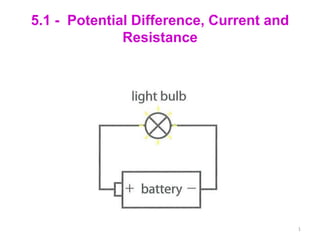
5.1 - Potential Difference, Current & Resistance
- 1. 5.1 - Potential Difference, Current and Resistance 1
- 2. How can we model electric circuits? A model can help us to understand how current works in an electric circuit. In this model, the moped riders represent the flow of charge and the pizzas represent the electrical energy carried around the circuit. What do the pizza shop and the house of party-goers represent?
- 3. Potential Difference The easiest way to think about what batteries do is to use a water analogy. Batteries ‘lift’ charges (Q) to a higher Potential (V). There is a Potential Difference (V) between one end of the battery and the other. Batteries store Potential Energy as Chemical Energy. 3
- 4. Battery Voltage Simulator on PhET website This simulator shows another way of imaging what batteries do. http://phet.colorado.edu/en/simulation/batte ry-voltage or click the pictures
- 5. Water model of a circuit This page has embedded flash which only works in Powerpoint.
- 6. What are Coulombs? Because charge is made out of electrons which are very small, it seems silly to measure charge in electrons because the numbers of charges that go round a circuit would be billions and billions. Instead Charge (Q) is measured in Coulombs (C) Using this scale 1 electron is only: 1.6x10-19 C 1 Coulomb is: 6,250,000,000,000,000,000 electrons Remember this number 6
- 7. Current (I) Batteries ‘lift’ charges to a higher potential. The charges then flow around the circuit. The flow of charges per second is called: current. Charge Current Time 7
- 8. What is conventional current? Before the discovery of the electron, scientists assumed that current was due to positively-charged particles moving from the positive terminal around a circuit to the negative terminal. This way of representing the direction of current is called Conventional Current. It is now know that charge is carried by electrons, flowing from the negative terminal to the positive terminal. This is called electron flow. Today, both conventional current and electron flow can be used to represent the direction of current.
- 9. Potential Difference (V) ..sometimes known as Voltage Batteries ‘lift’ charges to a higher potential. There is a Potential Difference because each coulomb of charge has a different potential energy at either end of the battery. Energy Potential Difference Charge 9
- 10. Electromotive Force(EMF) and Potential Difference: Potential Difference (V) Electromotive Force The total amount The total amount of Chemical Energy of Electrical Energy in the battery transferred to Heat transferred to by each Coulomb Electrical Energy of charge by each Coulomb of charge 10
- 11. Website Link or click on the picture 11
- 12. How do metals conduct electricity? It is the delocalized electrons involved in metallic bonding that allow metals to conduct electricity. The delocalized electrons are free to flow through the metal and so carry a current. Insulating materials do not contain free electrons and so current is unable to flow. Ionic solutions are also able to conduct electricity because they have mobile charge-carrying particles. delocalized electrons
- 13. Resistance (R) Some materials are better than others at allowing current to flow. A material that doesn’t let much current flow for a given Potential Difference is said to have a high Resistance. This resistance depends on the material and the dimensions of the conductor 13
- 14. Factors affecting Resistance on PhET website http://phet.colorado.edu/sims/resistance-in-a-wire/resistance-in-a-wire_en.html or click the picture. 14
- 15. Why does Length affect resistance? The affect of length of a wire on resistance can be understood by looking at the atomic structure. Resistance is caused by electrons colliding with metal ions. When the length of the wire is increased, the electrons have to travel further. So the chance of collisions will increase, causing the resistance to increase.
- 16. Why does Cross Sectional Area affect resistance? Increasing the thickness of a wire increases the cross sectional surface area that the electrons can flow through. This decreases the chance of collisions with metal ions. In thick materials the charge carrying particles are able to move through the conductor more easily, reducing resistance.
- 17. What is Resistivity? Resistivity is just a property of the conductor. Every material has a resistivity. It is actually the resistance of a 1m long piece of wire with a cross-sectional area of 1m2. As you can imagine this is always a very low number. For Copper ρ = 1.72 x 10-8 Ωm Units = Ωm
- 18. Battery Resistance Simulator on PhET website http://phet.colorado.edu/en/simulation/battery-resistor-circuit 18
- 19. Ohms Law Ohms law relates the current flowing through a conductor with the potential difference across it. V∝I V=IR R is the constant of proportionality between I and V 19
- 20. Both these circuits have 2 Volts per Amp or a resistance of 2Ω 20
- 21. Ohms Law simulator on the PhET website http://phet.colorado.edu/sims/ohms-law/ohms-law_en.html or click on the picture 21
- 22. Ohmic Conductor 22
- 23. Non-Ohmic Conductor The reason for this is that as the lightbulb gets hot there are more collisions between the atoms so the resistance increases 23